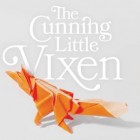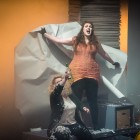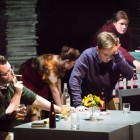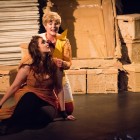Cunning Little Vixen 2017Byre Opera
Read more about the opera Cunning Little Vixen
Absorbing highlight of the operatic year
Byre Opera's project for 2017 again made a welcome contribution to operatic life on the east coast of the country. The number of live opera performances nationally and internationally is well known to be in decline. We are therefore more and more dependent on the creativity of small companies such as Byre for fine performances that can help to support the 'opera habit'.
On this occasion we enjoyed a fully staged production of Janáček's The Cunning Little Vixen, in the successful arrangement for chamber orchestra by Jonathan Dove. Interesting and engaging throughout, this made for an entertaining evening for an appreciative audience.
Michael Downes conducted an excellent band of just sixteen players - though half a dozen of them in fact doubled on two instruments at different times, giving a committed and absorbing performance.
The opera is composed in three short acts. Two intervals would nowadays seem too many, reducing momentum. The opera can be played in one sweep, perhaps with another short piece. A single interval seems in most respects desirable. Here the second act was divided. The final scene before the break shows the Vixen taking up life in the country while the humans complain about their problems. It does not have the obvious climax that the scenes on either side of it have, but dividing the evening this way still works well.
The cast includes current St Andrews students variously studying French, Italian, Classics and English, as well as local children. Indeed the Vixen is one of a small group of operas that requires excellent performances by young children - they represent not just a bevy of fox cubs, but other creatures, including caterpillar and frog. It must be great fun for them - some have to sing, though not all. Others dance, and they all have nicely designed costumes to wear.
The setting
In P J Harris's production, the set designed by Victor Labarthe d'Arnoux was different from the generally expected forest. It began as an office - the Forester is a bored bureaucrat, sitting at his PC stage left, taking the occasional swig from a flask. A rank of filing cabinets fills the back of the stage. A door blows open and sheets of paper are scattered. It is dark outside and a mosquito dances in, drawn by the light. The Forester follows it round the room trying to swat it. Wounded, it is succeeded by other creatures, including the young Vixen who is caught and tied up by the Forester. Time passes and the Vixen grows up - the mature singer swapping places in an elegantly choreographed sequence. A range of events follows - the Vixen rejects the advances of the Forester's dog, his grandchildren taunt the Vixen, who retaliates by biting one on the leg. The cockerel and his team of hens come in - the filing cabinets doubling as the boxes in which their eggs are laid. The birds are not intelligent and don't understand the haranguing of the Vixen, inciting them to revolt. Frustrated, she slaughters them and escapes, reducing the set to matchwood. The representation of the inn that follows is more vestigial. The production was full of detail without being too 'busy' but the cast lived up to the challenge convincingly.
The forest revealed after the interval is linked to the office environment seen before. The huge tree trunks are of newsprint. In autumn more sheets of paper are scattered around as falling leaves. The set is much simpler from then on, as the Vixen, her Fox and their cubs become the centre of attention.
Costume designs by Antonin Boyot Gellibert are derived from origami. Some of the animals are portrayed quite cleverly. The characters of the Priest and Badger are intended to be played by the same singer, so with the human in black draperies, he only needs an elegantly simple mask to be changed into an effective creature. Other animals such as the Woodpecker and Owl are also represented in elegantly simple style. The cockerel was dressed appropriately in more spectacular fashion.
Janáček is renowned for the way he wrote all his musical lines to fit closely his native Czech language. This makes it difficult for singers in other languages to project words clearly. The young singers did not always succeed, but those who had complete success in letting us understand were generally the lower voices - the Forester (Niall Kennedy), Poacher (Teddy Day) and Priest/Badger (Peter Sutton). The two leading sopranos, Catherine Hooper (Vixen) and Caitlin McDonnell (Fox) were appropriately well contrasted in tone and gave quite athletic performances. The two dragonflies, Anastassia Matviitsuk and Flora Betts, flitted in and out of the action, their appearances adding to the sense of nature infusing the music.
Education and community
A useful education outreach programme has been taking place alongside the performances, curated by Ellen Thomson. Around 60 pupils from Beath and Glenwood High Schools (Years S1-3) explored the scientific themes behind the opera. Working with composer Pippa Murphy they have taken part in workshops in art and science to develop a multi-media installation in response to the story, its themes and ideas. The results are on show at the Byre from 18 to 23 June. Pupils attended the dress rehearsal and were able to meet the participants.
Schedule of performances
The production opened at the Byre with three performances between 15 and 18 June, before touring to the Maltings Theatre in Berwick-upon-Tweed (two further performances on 24 and 25 June).
Great credit is due to the production team for this remarkable achievement.









